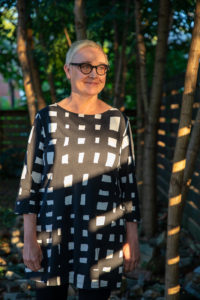The Oberlander Prize, an initiative of The Cultural Landscape Foundation, includes a $100,000 award and two years of public engagement activities focused on the laureate and landscape architecture
The Cultural Landscape Foundation (TCLF) has named Julie Bargmann (MLA ’87) the winner of the inaugural Cornelia Hahn Oberlander International Landscape Architecture Prize (Oberlander Prize), a biennial honor that includes a $100,000 award and two years of public engagement activities focused on the laureate’s work and landscape architecture more broadly. The Prize is named for the late landscape architect Cornelia Hahn Oberlander (BLA ’47) and, according to TCLF, is bestowed on a recipient who is “exceptionally talented, creative, courageous, and visionary” and has “a significant body of built work that exemplifies the art of landscape architecture.”

The international, seven-person Oberlander Prize Jury selected Bargmann from among over 200 nominations from across the world. In naming Bargmann the inaugural winner of the Oberlander Prize, Jury Chair Dorothée Imbert noted Bargmann’s “leadership in the world of ideas, her impact on the public landscape, her model of an activist practice, and her commitment to advancing landscape architecture both through teaching and design.” As Bargmann has said of herself: “The two ends of my barbell are designer-artist and political animal.”
“The goal in establishing the Oberlander Prize was to increase the visibility, understanding, appreciation and conversation about landscape architecture,” said Charles A. Birnbaum, TCLF’s President and CEO. “The selection of Julie Bargmann as the inaugural laureate, a provocateur and innovator, is an excellent way to engage the public and usher in this next phase of the Oberlander Prize.”
The announcement of the laureate will be followed by the inaugural Oberlander Prize Forum, Courageous by Design, on Friday, October 15, 2021, at Highline Stages in New York City, and focuses on the landscape architects who are the leaders in addressing the climate crisis in New York City.
A native of Westwood, New Jersey, Bargmann is a Professor of Landscape Architecture at the University of Virginia in Charlottesville, VA, and the founder of D.I.R.T. (Dump It Right There) studio. She attended Carnegie Mellon University, where she received a Bachelor of Fine Arts in Sculpture, and Harvard Graduate School of Design (Harvard GSD), where she earned a Master in Landscape Architecture in 1987. While studying at Harvard GSD, Bargmann and classmate Stephen Stimson (MLA ‘87) worked for landscape architect Michael Van Valkenburgh, Harvard GSD’s Charles Eliot Emeritus Professor in Practice of Landscape Architecture. Bargmann would go on to work for Van Valkenburgh over two stints until 1992, the year she began teaching at the University of Minnesota and founded D.I.R.T. studio.
In March 2021, Bargmann presented Harvard GSD’s annual Daniel Urban Kiley Lecture, with a talk entitled “Modesty.”
Bargmann first tested her design and teaching approaches through her work at mining and manufacturing sites. While at the University of Minnesota, she created “Project D.I.R.T.” and spent months examining mines in Minnesota, South Dakota, Wyoming, Utah, Arizona, Virginia, Kentucky, Indiana, and Illinois. “I studied and sometimes literally crawled through mining and manufacturing sites, many of them defunct,” Bargmann said. “I wanted to see how they were being treated, and in most cases, I disagreed with what I witnessed. Restrictive reclamation policies, uninspired remediation practices, and shallow readings of former working sites—I became openly critical of all these things but was also inspired by them. They instilled in me the desire to offer design alternatives and led me to create experimental studios.”
Bargmann also collaborated with the U.S. Environmental Protection Agency (EPA) on design studios focused on twelve Superfund sites, including Avtex Fibers in Front Royal, VA, Roebling Steel (site of the design and manufacturing of parts for the Brooklyn Bridge) in Roebling, NJ, that needed help with planning and design. Every site provided a lesson in looking at how to apply emerging technologies, rather than defaulting to conventional practices. Toxic sites become isolated by necessity but don’t go away, so D.I.R.T. sought to find ways to reconnect them to adjacent neighborhoods. Bargmann has consistently operated with the theory that industrial and social histories combine to create the connective tissue that reforms and revitalizes communities.
Bargmann has taught at the University of Virginia since 1995 and cited the “incredible support and trust from my colleagues at UVA to really do anything I want.” She added: “Teaching allowed me to really experiment. I don’t know how I would have done it just through practice.”
Formation of the Oberlander Prize began in 2014, amid TCLF’s efforts to prevent the demolition of the Frick Collection’s Russell Page-designed viewing garden on East 70th Street in New York City. The Prize is supported by a lead million-dollar gift by TCLF Board Member Joan Shafran and her husband Rob Haimes, as well as generosity of additional donors, including members of the 100 Women Campaign. The Prize has also benefited from strategic advice from Jill Magnuson and other senior leadership at the Nasher Sculpture Center, and from Martha Thorne, former Executive Director of the Pritzker Prize, among others.
“We are very fortunate, grateful and humbled by all who participated in this journey and for so many supporters,” TCLF”s Birnbaum noted, adding, “ and, most importantly, we have as our North Star Cornelia, the grande dame of landscape architecture.”